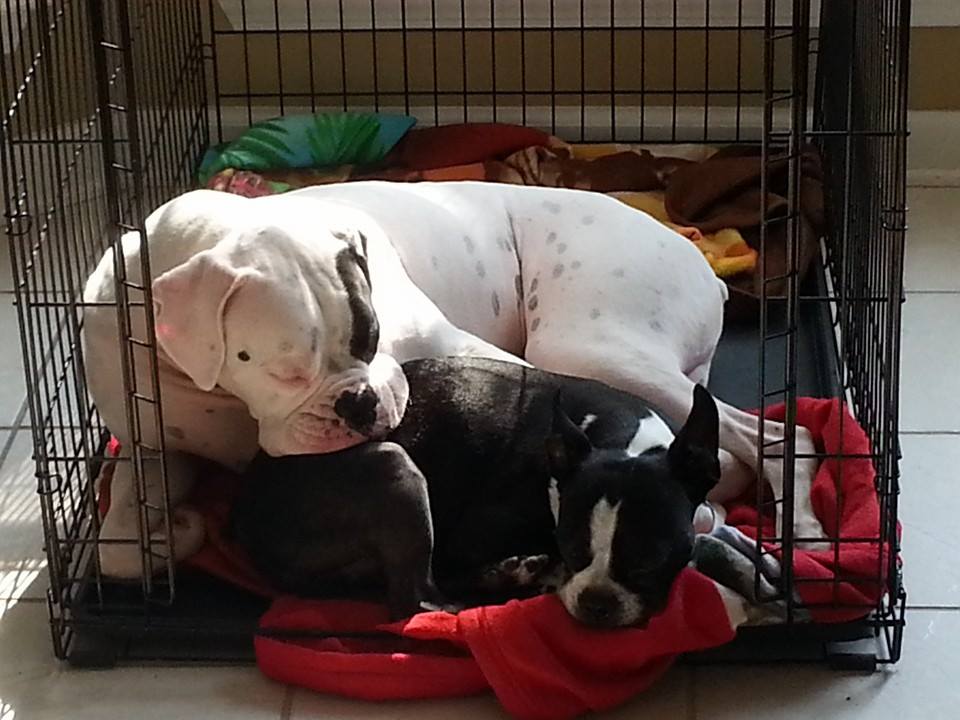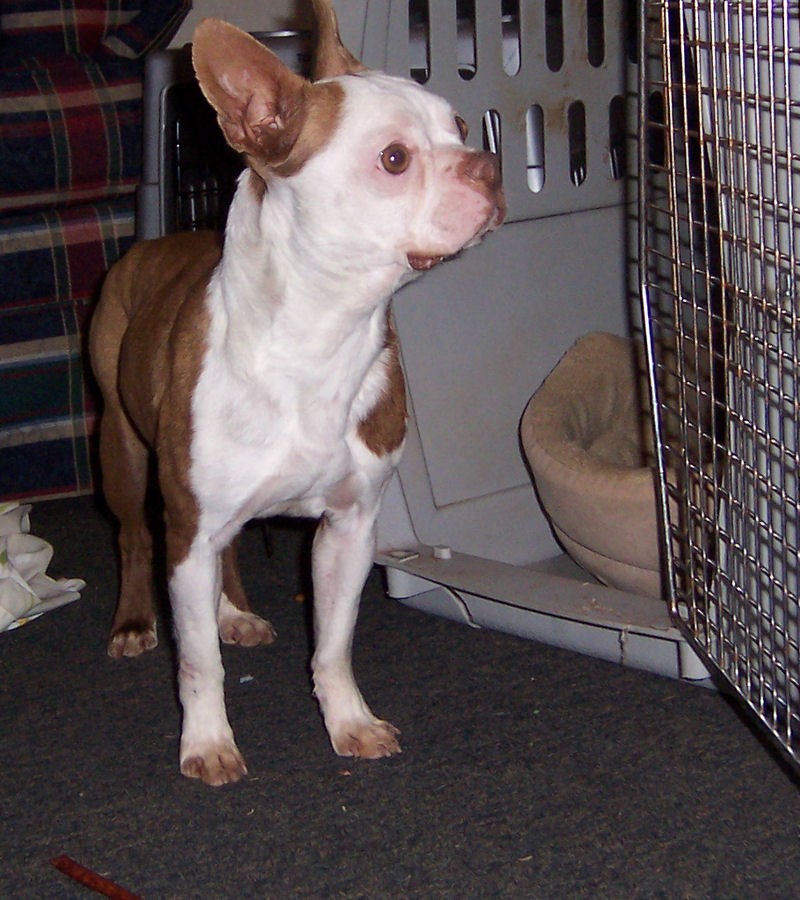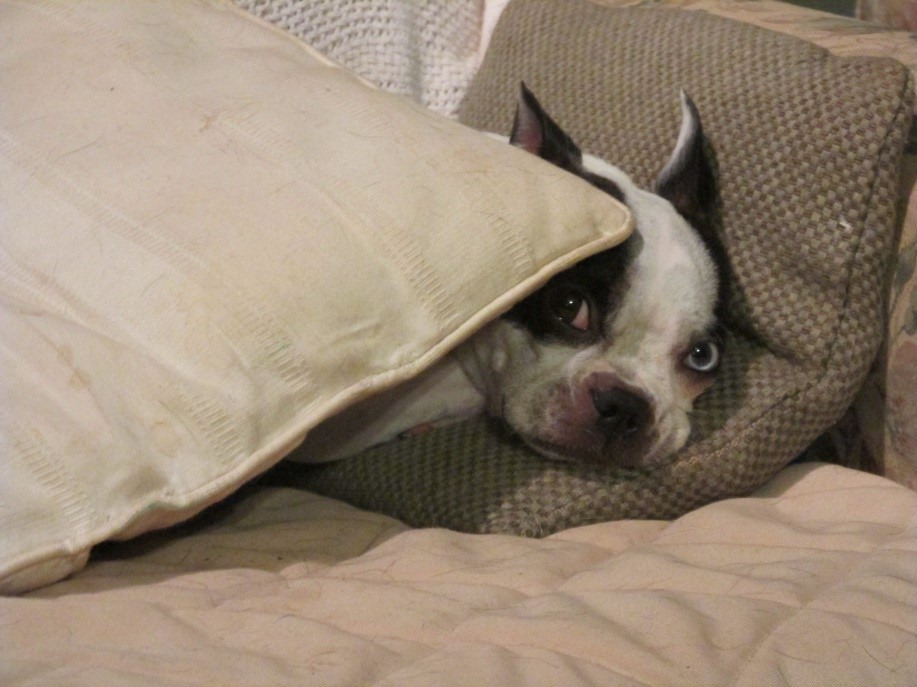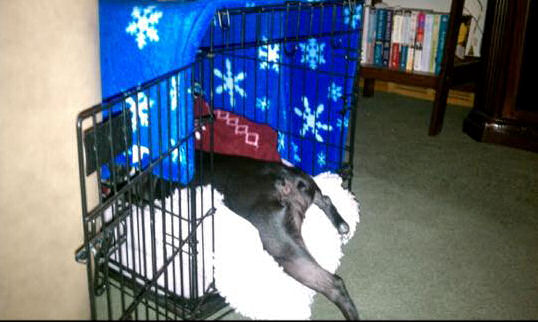
CRATE TRAINING PUPPIES : A ROOM OF HIS OWN
While the basics on crate training usually is aimed toward new puppies the method below if used should be valid for most dogs. This is not saying for some older dogs the training may take a lot more patience. The results will be worth it.
We know when done correctly this is a happy experience.
We suggest that it may be helpful to explain that even humans want a little privacy and most enjoy a den of their own. We call them bedrooms, dens, man-rooms, craft rooms, media rooms, garage. We as humans need to put aside our natural human thoughts of prison, punishment etc.
But whatever we call them they are places for relaxing, taking time for ourselves, reading, watching the game, tinkering on the auto, resting, working with our hobbies. Rooms that give us humans a sense of comfort and safety.
 So how does a properly Crate trained dog view a crate?
So how does a properly Crate trained dog view a crate?
It is his safe haven from the world. It is his bedroom. From his crate he gets used to new sights, sounds, and people without feeling pressured to react. A crate relieves him of all that responsibility and of the opportunity to destroy the house. Thank of this as their bedroom where a dog will want to go when they are feeling overwhelmed by all of the noise and activity of their family.


When you leave your Boston or Pug overnight at the Vets. Where does he stay?
What if your dog has to be boarded longer than planned, or is saved from a bad event and is found along with lots of other dogs. (Fire, tornado, flood, etc.) All our best laid plans might disappear. Even when they travel a crate may be required.
We understand there are many points of view on crating. But what we all want to do is make a possible traumatic event as less stressful as possible. Which is why we feel that it is so important that every dog is crate trained even if they seldom are required to be crated.
Nothing is more important than starting a young Boston's training experience on the right paw. It is so important that every dog is crate trained when young, we want our dogs to be able to be, if not happy, then at least not terrified when they are crated.
Because life is so full of the unexpected, we highly suggest this should just be part of their training. even if you do not intend to ever crate you beloved Frenchie, Pug or Boston.
Below is a standard method used by most trainers, but you can do this yourself in your own home.

Take a potty break first.
Make sure Sam has been outside to 'do his business' before you crate him, even for short periods (5 to 10 minutes to start). This way when he starts fussing right away you know he doesn't have an urgent need to 'go', this will cut down on the chances he'll eliminate in the crate, which defeats the purpose of crate training as an aid to housebreaking.
When you think Sam is ready to spend some time with the door closed, start with very short periods and work up.
Here are some more rules of crate training and a couple of pointers to make this part of crate training a puppy a bit less stressful for you both:
Put his favorite toy in with him.
It's a good idea to have a special toy for Sam to play with only when he's in his crate. Make sure it is something he really likes and is safe (no loose parts etc.). It will stave off boredom and help him forget he's not outside running around.
If you have an old blanket or something similar like an old unwashed t-shirt that you do not mind getting ruined (it's possible it'll get peed on, pooped on or chewed beyond recognition), you could put that in the crate also. Sam will feel happier and be reassured if he can 'smell' you right next to him.
Do not shut him in and then leave the room.
Young puppies want to be with their people at all times. If you disappear from sight he will be scared, and you do not want him to make those kinds of associations with his crate.
Ignore initial 'fussing'.
Almost all puppies will fuss and cry the first few times they are confined to their crates. Remember, they want to be right next to you at all times. If you take little Sam out as soon he starts whining, We can guarantee he'll whine even louder and longer next time. Anyone who has raised children will know all about this phenomenon! Stay close by, but ignore the racket and do not make eye contact.
There is one caveat here. Occasionally you will find a puppy that is particularly highly-strung and nervous who may suffer from severe separation anxiety when put in his crate. If your puppy appears 'hysterical' (whining, barking, scratching, throwing himself around, has a bowel movement or is panting heavily) it's best to let him out and consult your veterinarian or an experienced dog trainer for advice on how best to handle that. It may be that he has a tendency towards anxious behavior, such as separation anxiety.
Alone and restless, how could you leave me!
If your new dog will be left alone for several hours every day, start crate training now, even if you are just in the next room or in the house while he is out in the back yard. He needs to learn he has to spend time without you. A dog that gets constant attention and then is suddenly left alone for eight hours may bark, chew, or develop other behavior problems due to separation anxiety. When your dog is demanding attention, restless or feeling need, and you're busy, there are things you can do. Just because your dog is demanding attention, does not mean that he is always going to get it. Remember: You are the Alpha dog. You can put the dog in the kennel/crate.
However, do not be fooled too easily. (Dogs are smart, just like kids they know how to push your buttons.) Sam may act like a crazy dog for a few minutes, but then settle down to the occasional whine. If he is generally not an anxious, highly nervous dog, he's unlikely to develop raging anxiety issues because of his crate.
Freedom!
Wait for quiet before letting him out. Whether your puppy is in his crate for 5 minutes or 30, never open the door and let him out while he's crying and complaining. Wait for a lull first, or he will think he is getting out because he is making such a fuss.
Play Hide & Seek
Make crate training fun for the puppy by playing this game. Put a tasty treat or special toy inside his crate and then encourage Sam to 'find it." Using a happy, friendly voice say something along the lines of "where's your goodie? Let's find it?” Follow the search with praise, such as "Oh, there it is. It is in your crate (or bed, house, whatever you want to call it). What a good boy, you found it!"
I Want My Den! Confine your dog to a crate or a kennel when you can't supervise him. Dogs are "den animals." They derive a sense of security and well being when they're confined to a small, enclosed area. Think of a kennel in the same way you'd think of a baby's play pen or crib: If your dog isn't old enough (or responsible enough) to be left unsupervised-- then put him in the crate.
A comfortable dog crate can be the dog's private room and the owner's best friend. Appropriate use of a crate is a great aid to housebreaking, prevention of chewing and other destructive behavior, and a source of security to a dog who might otherwise suffer separation anxiety when left home alone; with some comfortable padding on the floor suits Boston's well.
A Blessing for foster homes.
Many foster homes crate-train most rescue dogs as soon as they enter the house, initially crating them (i.e. closing the dog into the crate) at night, feeding them in the crate, and crating them when they are left home alone.
Once the dog has adjusted well to being a house dog, the crate is simply made available with door left open for dog to use at will.
Many make frequent use of it for a private nap. Dogs love small, dark, enclosed places to be used as a "den", i.e. a private sleeping place. To a dog, a crate is a cherished private space, not a jail.
A similar result may be achieved by "dog proofing" (clearing out dangerous or destructible items) one room of the house, so the dog may be confined there when necessary. A dog proof room is not as powerfully relaxing as a crate, but it is often preferable to giving the dog free run of the house.
Alone and restless, how could you leave me!
If your new(or old) dog will be left alone for several hours every day, start crate training now, even if you are just in the next room or in the house while he is out in the back yard. He needs to learn he has to spend time without you. A dog that gets constant attention and then is suddenly left alone for eight hours may bark, chew, or develop other behavior problems due to separation anxiety. When your dog is demanding attention, restless or feeling need, and you're busy, there are things you can do.
Just because your dog is demanding attention, does not mean that he is always going to get it. Remember: You are the Alpha dog. You can put the dog in the kennel/crate.
Crate training method:
If they decide to act up while in the crate, say not a word... instead use a crate cover or item that you wear and place it over his crate. That way the room darkens for him and he has an owner's scent from the cover to console him. Now when he goes in his cage, tell him it is bedtime... he will learn to curl up on his pillow before you even get the door closed for the night.
What size should the crate be?
Do not crate your dog in an undersized crate!

BTN would love to hear from you on this subject. We always want to learn about additional hints you may be able to add to what we have written. You might even have a better method and we would be interested in learning from you. So do leave comments below or contactus@bostonterriernews.com Please put "Crate training" in the subject line. Thank you in advance.


